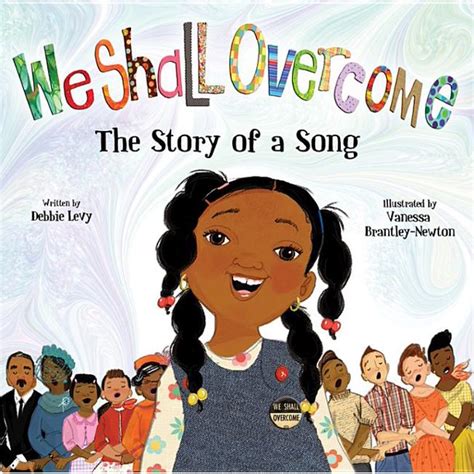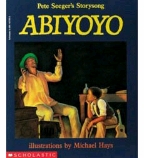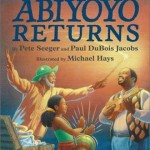Your Name is a Song

This is the book you need to start your school year.
A little girl is upset because her teacher and classmates not only can’t pronounce her name, they seem to think it isn’t important to say it correctly. When the little girl goes home upset, her mother tells her that her name is a song. So the girl goes back to school and sings her name, sings everyone’s name.
It is important to say names correctly. Everyone’s name.
I looooove the pronunciation key that comes with every name. We learn how to pronounce Ta’jae (TAH-jay) as well as Bob (BAWB). And if we can’t pronounce it correctly on the first try, we learn it – even sing it! – until we get it right.
You can listen to the author, Jamilah Thompkins-Bigelow read her book aloud here:
“We Shall Overcome”
Music can reach us in a way that nothing else can. During February – and every month – We Shall Overcome: The Story of a Song written by Debbie Levy and illustrated by Vanessa Brantley-Newton is a cross-curricular book you can use to teach American history and social justice.

The song, “We Shall Overcome” has its roots in the time of slavery in America. Its impact has lasted for over a century and has inspired change-makers around the world. The lyrics are interspersed through the book, along with gorgeous art showing moments in history when the song was sung.
Classroom teachers, music teachers, parents, and all those who work with children, you need this book. With your students, you can talk about what the lyrics of the song mean and why this song was and is important. The last illustrated page reminds us that the work for equality is not done. We need to raise our voices and declare that the barriers against justice will be overcome. Sharing books like We Shall Overcome: The Story of a Song will teach our children that they are a part of the change for good, too.
September Bonus List of Books and Activities!
Because I gave a presentation to awesome librarians this month and I couldn’t resist sharing all the great ideas we came up with, you get a bonus post this month! And because you’re getting a bonus post, I hope you’ll allow me to indulge in a bit of horn-tooting.
My debut picture book, GROUNDHOG’S DILEMMA, illustrated by Matt Faulkner (swoon!) will be published by Charlesbridge this December 1st, and it recently received a good professional review:
“Faulkner’s anthropomorphic animals and vibrant colors recall Uncle Wiggly, and the illustrations are packed with humorous details that repay rereadings. Remenar’s graceful prose and the subtlety of her message, pitched to older preschoolers and early-elementary students, are a good match. A sly and funny take on truth-telling and friendship.” – Kirkus, Oct. 2015
Woohoo!!!!!!!
Ok, horn-tooting over.
I spent a morning with a roomful of youth librarians and bunches of new books. We came up with these activities revolving around the key early literacy skills: Talk, Sing, Read, Write, Play. (Look here for lots more good stuff from Every Child Ready to Read.) Many of our activities can be used with a variety of books. I’m including our list of ideas and the books we shared. Enjoy!
TALK:
* Read Rufus Goes to School by Kim T. Griswell and talk about what you need for school, what you shouldn’t do in school, and favorite books you know how to read.
* Read Groundhog’s Dilemma by Kristen Remenar and talk about your favorite/least favorite parts of winter and spring. Talk about animals that hibernate and those that don’t. Talk about why the characters in the story wanted or didn’t want Groundhog to see his shadow.
* Read Clothesline Clues to Sports People Play by Andy Robert Davies and encourage kids to guess the sport. Discuss unfamiliar terms like foil and quiver.
* Use nonfiction books with photos of bees to go along with Bee Dance by Rick Chrustowski. Bring in a honeycomb and give kids bendy straws so they can act like the bees in the book.
* Read Pepper and Poe by Frann Preston-Gannon and discuss why Pepper feels the way he does.
* Discuss good and bad manners after reading The Entertainer by Emma Dodd.
* Encourage kids to respond to “which would you choose?” while reading Hot Rod Hamster by Cynthia Lord.
SING:
* Sing rhyming words, even nonsense ones, after reading Hi! by Ethan Long.
* Sing “Milkshake” after reading Lulu’s Party by Kit Chase.
* Sing the book Old Mikamba Had a Farm by Rachel Isadora.
* Sing “The Days of the Week” song after reading Pepper and Poe by Frann Preston-Gannon, or “If You’re Happy and You Know It”.
* Sing “Take Me Out to the Ball Game” after reading Groundhog’s Dilemma by Kristen Remenar.
READ:
* Read nonfiction books about groundhogs and Groundhog’s Day along with Groundhog’s Dilemma by Kristen Remenar. (It delights me every time I type it!) Use puppets to help narrate/read the story.
* Use magnetic or felt letters to rearrange and read aloud, after reading Little Bird’s Bad Word by Jacob Grant.
WRITE:
* Kids can decorate the first letter of their name or make pictures with die-cut letters after reading Alphabeasties by Sharon Werner and Sarah Forss.
* Write your own “wumbers” inspired by Wumbers by Amy Krouse Rosenthal and Tom Lichtenheld.
* Draw or write about something you cherish after reading Thankful by Eileen Spinelli.
* Trace your shoes and decorate the tracings after reading Whose Shoe? by Eve Bunting.
* Write a letter or draw a picture to convince Groundhog to predict winter or spring after reading Groundhog’s Dilemma by Kristen Remenar. Kids can write and draw about a time when they’ve had to resolve a dilemma. Outside with chalk, or inside on paper, kids can trace their own shadows!
* Create maps of your playground, classroom, school, library, etc. after reading Henry’s Map by David Elliot.
* Paint Q-tip paintings of trees inspired by Fall is Not Easy by Marty Kelley.
* Write your own “word equations” inspired by This Plus That by Amy Krouse Rosenthal.
PLAY:
* Use a string and pin it to a world map to show all the places from Because Amelia Smiled by David Ezra Stein. Compare it to Madlenka and Nothing Ever Happens on My Block.
* Act out Uh Oh! by Shutta Crum.
* Play a version of “Going On a Bear Hunt” after reading In the Canyon by Liz Garton Scanlon.
* Incorporate different dances like The Hokey Pokey and The Twist and act out The Sky Is Falling by Mark Teague. Have a dance party!
* Create hand/body motions and make the sound effects for Niňo Wrestles the World by Yuyi Morales. Come up with other characters who might want to wrestle!
* Move like cats and act out the emotions from Pepper and Poe by Frann Preston-Gannon.
* Have a storytime party where kids act out what should and should not happen at a party after reading The Entertainer by Emma Dodd.
* Paint small boxes like houses after reading Vincent Paints His House by Tedd Arnold.
* Rearrange letter tiles to show how one word can become another after reading One Boy by Laura Vaccaro Seeger.
* Act out Groundhog’s Dilemma by Kristen Remenar. (Still fun to type!) Little ones can curl up in a box and pop out for Groundhog’s Day to look for their shadows, or try making shadow animals on a wall.
Abiyoyo and Abiyoyo Returns
 It’s almost Halloween, and you want a book to share with your students that will give them shivers, but not nightmares. Pull out these picture books about a scary giant and the clever little boy who defeats him, and you’ll be hitting the Common Core State Standard of Integrating Knowledge and Ideas while you thrill your listeners.
It’s almost Halloween, and you want a book to share with your students that will give them shivers, but not nightmares. Pull out these picture books about a scary giant and the clever little boy who defeats him, and you’ll be hitting the Common Core State Standard of Integrating Knowledge and Ideas while you thrill your listeners.
Inspired by a South African folktale, Abiyoyo is a storysong written by the folk music master Pete Seeger and illustrated by Michael Hays. A little boy is always in trouble for making noise with his music. His father is shunned by the neighbors for playing too many pranks, making things disappear with his magic wand. But when fearful Abiyoyo comes, the little boy sings until the giant falls down from dancing, and the father uses his magic wand to make Abiyoyo disappear.
 Compare this classic to its sequel, Abiyoyo Returns written by Pete Seeger and Paul DuBois Jacobs, and illustrated by Michael Hays. The little boy who made Abiyoyo disappear is now a grown man, and his town needs a giant’s help. With the help of the magic wand, Abiyoyo returns and the townspeople teach him to help rather than to harm.
Compare this classic to its sequel, Abiyoyo Returns written by Pete Seeger and Paul DuBois Jacobs, and illustrated by Michael Hays. The little boy who made Abiyoyo disappear is now a grown man, and his town needs a giant’s help. With the help of the magic wand, Abiyoyo returns and the townspeople teach him to help rather than to harm.
There’s a terrific “Reading Rainbow” video of Pete Seeger telling/singing the first book (available for free on Youtube) and an audio cd available as well. Share the audio recording of Abiyoyo along with the book so your students can listen to a master storyteller. (You’ll enjoy listening to him as much as your students do, and it’s amazing how listening to a different voice than the one they hear all the time can perk up ears during a read-aloud.) Before reading Abiyoyo Returns, predict with your students how the people will handle Abiyoyo when he comes back. Contrast how Abiyoyo is the problem in one story and the solution in the other.For a fun art extension, get dowels from the hardware store (you can find them for less than $1 – cut them in half and they’re even less expensive!) and decorate your own magic wands. If your students are plagued with Halloween wiggles, let them sing the Abiyoyo song and dance around until they fall down. When you wave your wand to magically transport students back to their seats, their Halloween wiggles will have vanished!
Read More






